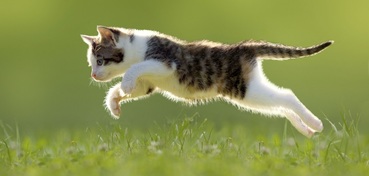
As we all know, diet is the foundation of health. And of course we all want our cats to have the best we can provide. But with the vast array of choices (all of which are marketed as optimal nutrition), for bewildered pet parents it can be very difficult to sort out which claims provide real information and those that are just marketing hype.
To make an informed decision, it helps to understand what it means that our cats are strict – “obligate” – carnivores.
What is an “obligate carnivore?”
An obligate carnivore is an animal that by its genetic makeup must eat the tissue of other animals in order to thrive. Everything about the cat is defined by its role as an apex hunter. Cats have evolved unique anatomic, physiologic, metabolic, and behavioral adaptations consistent with eating a strictly carnivorous diet. Some examples:
- Cats have a higher protein requirement than even most other carnivores.
- Cats cannot downregulate protein metabolism. If they do not get enough meat-based protein, they rob their own muscles for it.
- Cats must have preformed arginine and taurine (amino acids which humans synthesize). A lack of these in the diet rapidly causes blindness and death: only animal protein provides these at levels cats require.
- Cats lack the digestive enzymes necessary to derive anti-inflammatory benefit from plant-based omega 3s. Flax seed is a current popular addition to cat foods – it is marketed to humans as being one of the plant sources highest in omega 3s, yet cats are unable to access the EPA (eicosapentaenoic acid) and DHA (docosahexaenoic acid) within it. The omega 3 in plants is in the form of ALA (alpha-linoleic acid). According to Dr. Jean Hofve, in IVC Journal (Summer 2015) "while ALA has beneficial effects of its own (particularly on skin and coat health)... even though ALA is technically a precursor of EPA and DHA, dogs and especially cats have an extremely limited capacity for converting it (no more than 1% to 2% for EPA and virtually 0% for DHA after weaning). Only marine-sourced oils (fish oil, cod liver oil, krill oil, green-lipped mussel oil, and some algae oils) contain the pre-formed EPA and DHA that our carnivorous animals can absorb and utilize. Cats and dogs must receive EPA and DHA directly." To derive the anti-inflammatory and antioxidant benefits, cats must have preformed omega 3s, available only from animal tissue.
- Cats lack the digestive enzymes necessary to derive benefit from plant-based sources of vitamin A and must have preformed vitamin A from animal tissue. Vitamin A comes from two sources: retinoids (animal-based) and carotenoids (plant-based). Cats cannot convert carotenoids (like beta carotene) into usable vitamin A. Cats cannot access the vitamin A from common ingredients we see in cat foods such carrots, pumpkin, sweet potato, spinach, and kale.
- Cats do not synthesize vitamin D from sunlight, and their bodies use vitamin D from animal tissues (cholecalciferol) much more efficiently than plant-based vitamin D (ergocalciferol).
- Cats appear to have a carb threshold,
- Energy from carbohydrates cannot replace needed energy from protein.
- The sugar transporter in cats’ intestines is nonadaptive to changes in dietary carbohydrate levels.
- Salivary amylase, the enzyme used to initiate digestion of dietary starches (carbohydrates) is absent in cats, and intestinal amylase appears to be exclusively derived from the pancreas. In fact, cats have just one pathway for digesting carbohydrates (compared to dogs and people, who have multiple pathways). Of course, these enzymes are not necessary in a prey-based diet with minimal starch content.
- The level of pancreatic amylase is only 5% that of dogs.
The evolutionary history of the cat indicates they have eaten a purely carnivorous diet throughout their entire development. It is critical to their long term health that we understand cats are a metabolically inflexible carnivore.
EZcomplete fur Cats is designed to help you feed your carnivore right!
